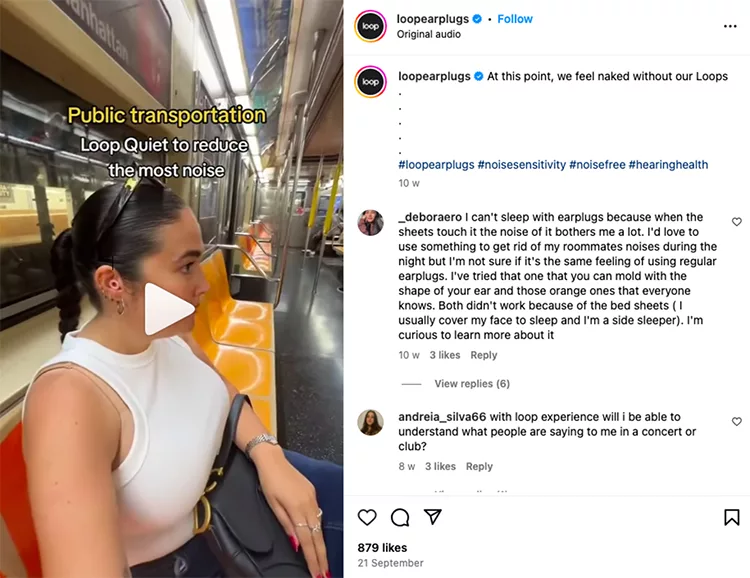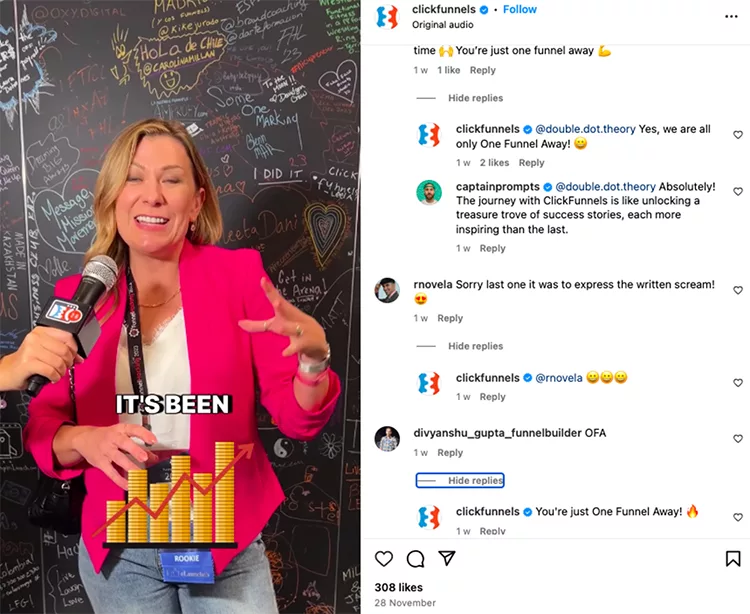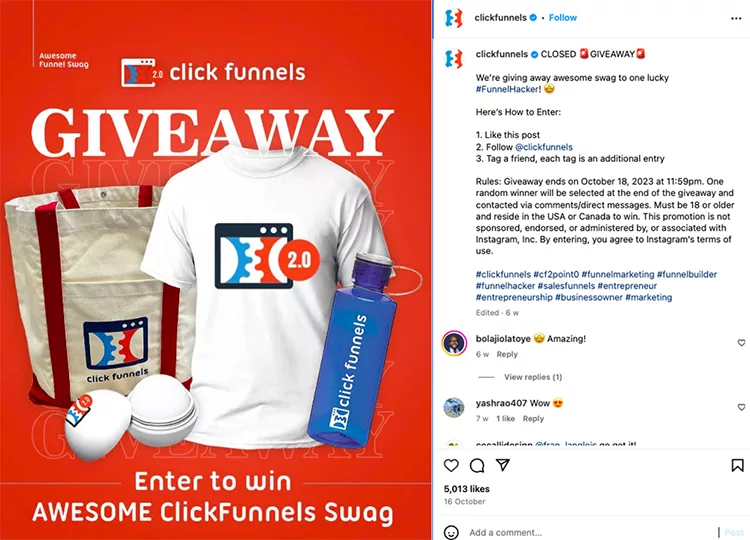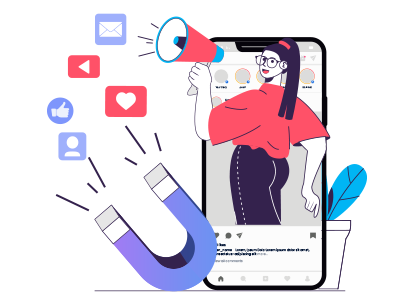Social media today is about more than just sharing updates with your friends.
It has become THE place where people ‘hang out’ and engage in commerce and conversations with brands they know and love.
For your business, having a strong social media presence is considered a seal of credibility.
If you’re looking for ways to take your Instagram marketing strategies to the next level, we’re going to show you exactly how to build that strong brand presence — and claim that seal of credibility.
We’ll even discuss strategies to get more eyeballs (and sales) from your IG account.
To get things started…
Step 1— Optimize Your Bio
When it comes to the impression you make on your audience, your bio is one of the first things they’re going to see on your Instagram page.
It helps them understand what to expect from your account.
And it’s your first opportunity to set the stage for the conversation you’ll have with them.
Your bio shouldn’t only just attract attention but it should also help turn visitors into followers, and then followers into customers or long-term brand advocates.
Take a look at this example to see what a great bio looks like:

Now, when you’re ready to start designing your bio and setting it up to help convert attention into followers, there’s a handful of tips you’ll want to follow.
As you’ve seen broken down in the example above, a lot of thought goes into the little bit of space you have available.
Here are some of our recommendations for nailing your bio description.
- Value Proposition: For your value proposition, you want to focus on communicating the value that you’re delivering to your followers — what’s in it for them?
- You don’t just want to tell them what you do but also make sure the core message in your bio revolves around answering the big question, “Why should I follow or engage with you?”
- Profile Photo: On your profile photo, you have two options. Either using your brand’s logo or a personal photo of the face of the brand.
- If you want people to resonate with you, we highly recommend using the face of the brand. If you want people to immediately recognize your brand when they see you around, use your logo.
- Bio Description: For your description, you have a minimal amount of space available to get your value proposition across to your audience.
- As you’re writing this, you want to be crystal clear about what’s in it for them if they follow you and engage with your brand.
- Keywords: You’ll also want to include relevant keywords that potential followers may be using to find content just like yours. This will help shoot your brand to the top of the search pages.
- Emojis & Spacing: A big part of your bio is built around grabbing attention and then keeping it.
- You can use emojis and spacing hacks to break up text and make sure your messaging is easy to read, stands out, grabs attention, and guides your reader’s eyes where you want them to go.
- CTA: Based on your end goal, you’ll want to decide on the primary action you want your visitors to take when they land on your page and then use your bio to guide them toward it.
- As a general rule of thumb, you’ll want to direct your visitors to a specific landing page or lead magnet on your website instead of just sending them to your homepage.
If you don’t already have landing pages or lead magnets built, you can start playing around with different designs and templates with your free ClickFunnels trial.
Click here to start your free trial now.
When you do, you can browse our library full of custom templates ready to plug into your funnel.

You can edit the templates using our drag-and-drop visual editor.

Then, traffic that you drive from your Instagram page will get captured and brought into your world instead of letting them randomly browse through your website hoping they convert.
Step 2— Lay Out The Highlights
The next step is making sure your highlights section actually highlights your business.
Your highlights are permanent collections of your best content or the pages on your website and in your funnel that you want to bring people’s attention to.
Unlike Stories that disappear after 24 hours, highlights are curated collections of Stories that can remain on your profile indefinitely.
You can organize your highlights by common themes, too.
Instead of just randomly tossing a bunch of content into your list, make sure you’re sticking with a thematic display that actually matters to your audience.
You can display it directly under your profile and bio description.

These highlights are the key to guiding your visitors through a conversion funnel, leading them from their initial interaction with your brand to deeper engagement — and, then, hopefully, a business transaction.
For example:

By moving through the Highlights on this page, a follower can go from discovering the brand (Press) to learning and engaging with their content (Podcasts, AMA).
Visitors will also see proof of effectiveness and results (Students) and understand more about the brand’s background and why they do what they do (About).
They’ll be given options to choose from if they want to dive deeper or get more help (Programs) and develop a personal connection with the brand by seeing where Ramit has traveled (Recent Travel).
That last addition creates a personal touch with the brand to help make it more approachable and relatable, which is important for maintaining a connection even after a transaction.
For even more ideas to include in your highlights, take a look at this list:
- About Me
- Services
- Testimonials
- Tutorials
- Frequently Asked Questions
- Contact Information
- Events
- Portfolio/Work Examples
- Customer Reviews
- Special Offers
- New Products/Features
- Community/Charity Work
- Press Mentions
- Behind The Scenes
The key here is helping your visitors easily navigate their way through their journey with your brand.
You want to make it as easy as possible for them to find key information you know they’ll be looking for when they begin engaging with your page.
You also want to include at least[ one link that leads to a landing page where you’re able to collect their information and then move them off of Instagram and into your captured ecosystem.
If you don’t already have a funnel to guide your visitors through, check out the Own Your Future Challenge to get started now.
Step 3— Collaborate With Other Creators
Now, once your Instagram page is optimized and ready to start driving traffic to, you’ll want to actually start shifting your focus onto driving traffic to it.
One of the best ways to make that happen is by collaborating with other creators who you may already share an audience with.
There’s a TON of people online who create content — any type of content.
Over the last handful of years, content creation has bloomed into a legitimate career path so, with a bit of research, you can discover other creators whose aesthetic and audience align with your marketing and business goals.
By collaborating with them, you can effectively share audiences with each other, so you get what you want and the content creator you collaborate with gets what they want.
It’s a win-win for both of you!
To see what this looks like in action, take a look at this example:

In the example above, loopearplugs is working together with an influencer to help introduce their product to the influencer’s audience.
In terms of efficiency in your marketing efforts, collaboration and working together with influencers is one of THE most effective, efficient strategies you can use.
From a cost-efficiency perspective, you’re able to invest the money you’re saving through working with influencers to invest back into ads and testing.
From a content perspective, the mix of educational, informational, promotional, and influential content you’ll get from a diverse range of creators helps appeal to your diverse audience.
To see what we mean, check out the loopearplugs page:

Collaborating with other influencers also typically provides a quick turnaround time.
You can quickly launch a campaign, at any time, with much delay — which lets you move significantly faster as you begin to test and roll out new products or lines.
Since creators do this for a living, they have a keen eye for what’s already trending, and what people like to see, and they’re incredibly creative so you’re getting a wide range of content styles.
More importantly, though, the content they create authentically resonates with their audience.
It builds a deep connection that gets translated into a connection with your brand.
This helps drive engagement, builds trust, and creates a more loyal customer base.
Take a look at this influencer post:

It has generated over 18,000 likes and a ton of comments.
Can you imagine what that would do for your brand and branding?
To get started collaborating with other creators, there are a few tips and steps you’ll want to take.
- You’ll want to keep the creator in mind when it comes to payment. Many times, creators will accept free products in exchange for a shoutout or collaboration.
- You may also want to pay them a lump sum for a specific amount of content. For instance, you can pay them one time for a series of 10 pieces of content spread out over a month.
- Some creators may work with you in exchange for free products plus an extra perk like a discount for their audience, family, or friends, or even a swag pack from your brand.
The key here is to ensure you have a fair compensation structure in place based on the size of their audience and how much traffic you believe they’ll drive to your brand.
This can be anything from monetary payments to free products, or other mutually beneficial arrangements.
Then, when it comes time to start working together, provide them with a clear guideline on what you expect, in terms of content, but give them the space to express their creative freedom.
Step 4 – Create A Content Calendar
For social media marketing, consistency is crucial.
If you’ve never heard of one before, a content calendar is a schedule that businesses, brands, and content creators use to put out their content in advance — on a set schedule.

If you want a quick start on creating your own, check out this spreadsheet.
There’s a handful of key elements that you’ll want to define inside of your content calendar so you can tailor your approach to your specific needs and goals.
- Timeline: The timeline you specify dictates when each new piece of content will be published, including the day and time. This helps set deadlines and getting it created to help remind you when it needs to be published.
- Content Details: The content details specify the type of content you’re going to be publishing, from blog posts to videos, images, stories, etc. It also includes the content title and the big idea that you want to convey to your audience.
- Publishing Platforms: The publishing platform determines where all your content is going to be published. This can be on your company blog, Instagram, Facebook, Twitter, LinkedIn, etc., wherever your audience may be waiting.
- Status Tracking: This helps track the progress of the content you’ve created, from the starting idea to the production, editing, final approval, and publication. This is helpful if you have a team working with you on content creation.
- Responsible Parties: When you have a team helping you handle the creation, the responsible parties section lets people know who is in charge of getting the content through to the next stage, whether that be creation, editing, approval, or posting.
- Marketing Campaigns: This section aligns each individual piece of content with your bigger marketing campaigns, product launches, or events, to ensure you’re driving traffic to the right places and tailoring your content to specific end goals.
- Metrics: You’re also going to want to monitor key metrics and performance indicators to evaluate whether or not the content has been successful after publishing. These metrics are what you’ll evaluate to figure out what you want to replicate.
When you get this right, having a content calendar can provide a huge boost to your marketing efforts.
It helps you plan for seasonal content, holidays, sales promotions, and big product launches while also helping you avoid gaps in your content marketing strategy. This helps you stay on top of your audience’s mind every day.
It also ensures that each and every piece of content you create serves a purpose and contributes to your bigger goals and marketing strategies.
When used properly, a content calendar will give you and your team the time needed to create high-quality content without rushing through the process — which means your content will be more effective since you’re able to plan ahead.
Step 5 – Build Cohesive & Consistent Branding
On the branding side, it’s not just your brand’s aesthetics that help you stand out in a busy crowd.
It’s also about maintaining a consistent and cohesive look and feel across all of your marketing materials and campaigns, especially on Instagram.
Having a cohesive branded look helps you create a seamless experience for your customers no matter where they encounter your brand.
When you’re designing your brand, there are key elements that will contribute to a cohesive look and feel across all of your content and platforms.
Color Palette: Using a consistent theme in the colors you choose is a great way to stand out and get people to immediately recognize your brand and your content. You’ll want to keep this consistency across all of your posts and platforms.
- Pro Tip: Use a tool like Coolors.co to generate a color palette that perfectly matches your brand and style.
Typography: After you’ve developed a color palette that you want your brand associated with, the next step is choosing the right typography. With a combination of the same color scheme and the same font across all of your content, your audience will immediately recognize you.

Imagery Style: On top of your colors and typography, your audience will also recognize your brand by the style of images that you create.
Maintaining a consistent look and feel with your images can have a huge impact for you on platforms like Instagram where a picture can speak 1,000 words and, maybe your only shot at grabbing and keeping the attention you’re looking for.
Whether it’s through the use of filters, the composition you use, or the subject matter you feature in your images, it’s key to maintain consistency with everything you publish.
Check out this example from Snif.co to see what success looks like here:

You can also vary the themes according to your product launch.
As an example, Olipop uses different colors for different flavor launches.
Behind each photo is a playful and bold visual style that features a pop-art feel, high saturation, and contrast that ties them together aesthetically.

Their ginger ale flavor launch is featured above, and their orange crush flavor launch is below.

You can see from both styles, though, that the brand is maintaining a consistent look and feel even though both product launches are incredibly different.
Graphical Elements: You’ll also want to be consistent with the graphical elements you create. This includes everything from your logo, to icons, your watermark, you name it.
Check out how Marketing Harry does it below:

It’s worth spending time upfront mapping what you want your brand to look and feel like so that you can create the consistency needed to stand out in a crowded marketplace.
Having a clear structure will also help when you start bringing on creative people to help handle the content creation workload.
Step 6 – Interact With Your Followers
As you start gaining traction on major platforms like Instagram, you don’t want to just leave your audience hanging after they’ve taken time out of the day to interact with your content.
Instead, you want to dive in and start engaging back with them.
When you do this, the Instagram algorithm will start favoring your content, showing it to even more people across the platform.
Posts with high engagement, people interacting in the comments, and sharing it across their own feed will dramatically increase the visibility of your posts.
And when a brand responds to comments, it shows that there are real people behind the account, which can help humanize the brand and make it even more relatable.
Check out the ClickFunnels Instagram account to see what we mean:

Now, when you want to do this well and not just seem like you’re fishing for engagement, there are a few things you can do that will make a massive difference:
- Timeliness: Responding to comments as quickly as possible plays well in your favor, both from the algorithm’s perspective and from your audience’s perspective. The sooner you’re engaging with people, the more appreciated they’re going to feel.
- Personal Responses: To increase engagement, you want to avoid generic responses. Instead, you want to personalize your response to show your followers that you value their input and are paying attention instead of just checking off a box by showing you replied.
- Encouraging Conversation: You’ll also want to ask questions and encourage followers to share their thoughts in order to keep the conversation going. Remember, the more people respond in your comments, the more the algorithms will favor your content.
To see a great example of doing it right, check out the comments on Jamie Brindle’s content:

If you have a team of people helping you with this, make sure they’re trained on your brand’s voice and how to properly engage with your followers in an appropriate way.
Then, you can use tools to help manage your comments, like Hootsuite, Buffer, Sprout Social, or Later.
These tools will typically include features that allow multiple team members to access and respond to comments on your content.
Then, responses to those comments can be directed to the members on your team who commented first, making it easy to manage and organize your engagement.
As always, though, remember that you’re engaging with people first, and the algorithm will reward you with greater reach.
Don’t make the mistake of just trying to appease the algorithms while giving bland, generic, boring responses to your audience — because they’ll stop engaging and the algorithms will be negatively impacted.
Step 7 – Post Relevant Content
Now, the final step in the Instagram equation is making sure that you’re posting content that’s relevant to your audience and what they want/expect to see from you.
Start by understanding that people come to these platforms to be entertained, informed, or educated, so mix up your content accordingly.
Entertainment: Humans have an innate desire for enjoyment and distraction from everyday life. Content that entertains them taps into this desire, creative positive associations with your brand as people are scrolling through their Instagram feed.
To capitalize on this, you’ll want to post funny, lighthearted, or heartwarming content and use memes, relatable stories, or showcase your brand’s personality in a way that makes your audience laugh or smile.

Inspiration: Share real stories and videos from people who started using your product and saw the results you promised. This will help add credibility to your brand, building trust, while also increasing engagement and entertaining your audience.

You can also overlay motivational quotes on images of your product being used to help make your brand memorable and have a positive impact on people who see your content.

Education: There’s a deep-rooted desire for growth and learning.
Educational content satisfies this desire by helping viewers improve themselves or their lives in some way, shape, or form.
To capitalize on this, you can create how-to videos, tutorials, and informative guides that empower your audience. This not only provides value but also builds trust and credibility in your brand.

To help get your creative wheels spinning, here are some additional ideas for content you can post.
Behind The Scenes:

Launch Posts:

Giveaways:

You can also post content like how-to videos, flash sale announcements, interactive polls, and more.
Your creativity is really the only limit.
As long as your content is designed with your audience in mind, and entertains, informs, or empowers in some way, then you engage when your audience engages, the algorithms will reward you with more visibility — which can directly translate into more revenue for your brand.
To get started, work on optimizing your bio and then build a list of collaborators you may want to work with in the future.
Then, make sure you’re driving them to a proven, high-converting landing page and getting them into a funnel where you can contact them outside of the Instagram platform.
If you don’t already have a funnel in place, click here now to start your free ClickFunnels trial.

